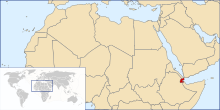Djiboutian cuisine

The Djiboutian cuisine is a rich mixture of the Somali, Afar, Arab and French cuisine with a bit of influence from the Asian and Indian style of cooking. The cuisine of Djibouti is unique on its own. Meals are typically halal. Some of the popular cuisine in Djibouti is made with a variation of fresh seafood and meat. One of the popular dishes in Djibouti include the Fah-fah or Soupe Djiboutian which is spicy boiled beef in soup.
Breakfast

Breakfast is an important meal for Djiboutian people, who often start the day with some style of tea. The main dish is typically a pancake-like bread called Lahoh, which might also be eaten with a stew or soup. It is similar to the Ethiopian injera but smaller and thinner. A side-dish of liver, goat meat, and iced beef cooked in a bed of soup or jerky, may also be served. Three pieces of lahoh are often eaten along with honey, ghee, and a cup of tea.
Lunch
Lunch (qado), (qeerokkalo) is often an elaborated main dish of Beyond the many styles of stew (maraq), rice is often served at lunch with meat and/or banana on the side. In Djibouti city, steak and fish are widely consumed. Pasta (baasto) is frequently presented with a heavier stew than the Italian pasta sauce. As with the rice, it is also served with a banana. Grilled meats are frequently served with the pasta. Djiboutian cuisine are commonly prepared using a lot of spices, ranging from saffron to cinnamon, bearing a trace of the Arabic influence on the nation’s cuisine and culture as a whole. Spicy dishes come in many variations, from the traditional fah-fah (spicy boiled beef) to the yetakelt wet (spicy mixed vegetable stew). Popular side dishes are lentils and rice, which are typically covered with sauces such as the hot berbere or the buttery nitter kibbeh.

Snacks and sweets
Sambuusa, the Somali version of the triangular samosa snack, is commonly eaten throughout Djibouti during the afur (iftar). The local variant is spiced with hot green pepper, and the main ingredient is often ground goat meat or fish. Xalwo (pronounced "halwo") or halva is a popular confection served during special occasions, such as Eid celebrations or wedding receptions. Garoobey is one of the staple dishes of Djibouti. The garoobey or oats porridge is prepared by soaking oats in milk and are flavored with cumin or cumin powder. Fruits such as mango, guava (Seytuun), banana (moos) are eaten throughout the day as snacks.
After-meal

Djiboutian people traditionally perfume their homes after meals. Frankincense or a prepared incense, which in countries in the Arabian Peninsula is known as bukhoor, is placed on top of hot charcoal inside an incense burner or censer. It then burns for about ten minutes. This keeps the house fragrant for hours.
